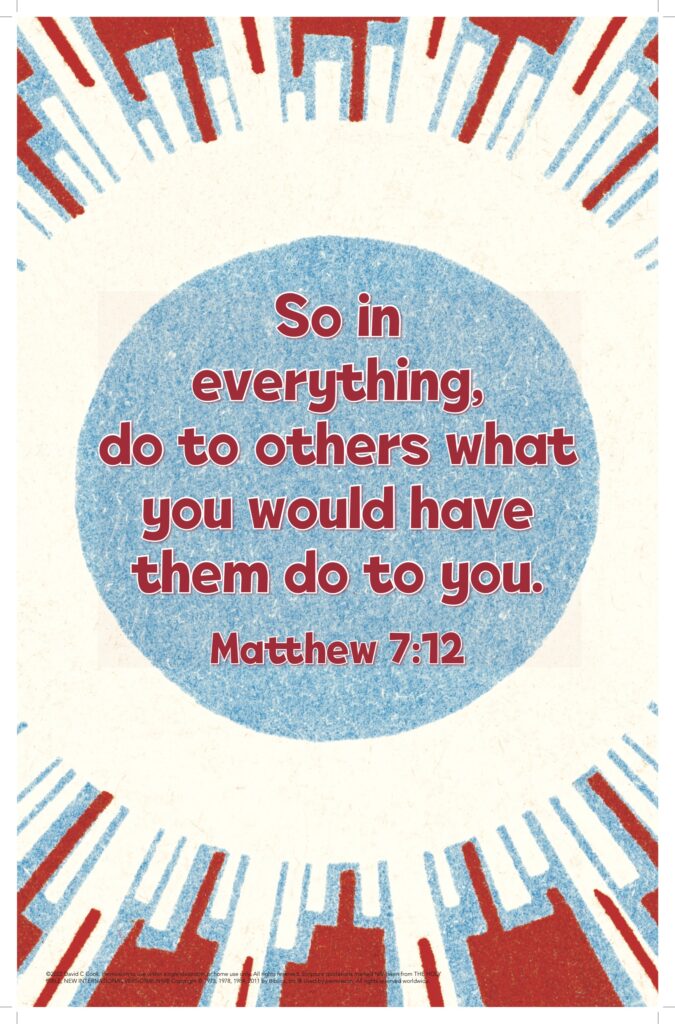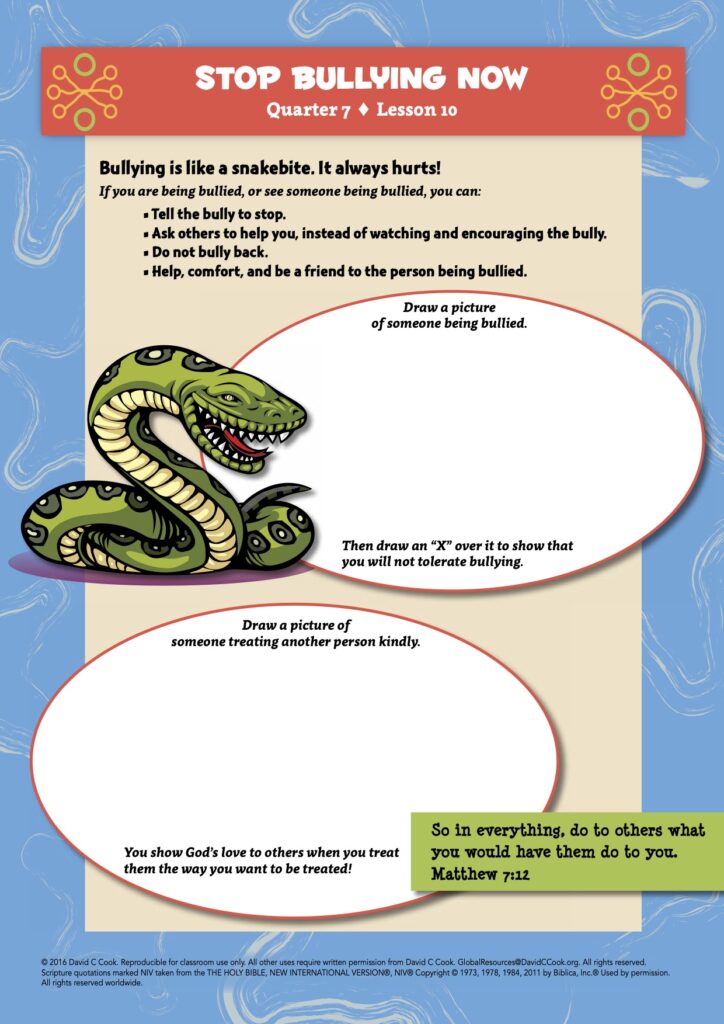During the lesson, the information for you to know is written in regular type, and what we suggest speaking or reading aloud to children is in bold. All resources for this lesson, including the Teacher Guide, Student Page, Family Connection Card, and other resources can be downloaded in a ZIP file by clicking on the following link:
In some lessons you will find "resource articles." These are articles written by experts from around the world to help equip you for your work with children and adolescents. Share them with parents or guardians if you consider it appropriate.
The King will reply, “Truly I tell you, whatever you did for one of the least of these brothers and sisters of mine, you did for me.”
Matthew 25:40
People who are weak, not so clean, less attractive, different. Have you ever passed them by, ignoring their needs? Have you even laughed behind their backs? If you have a Bible, read the parable of the Good Samaritan in Luke 10:30–35. When a priest saw the injured man lying beside the road, he crossed to the other side. When a Levite saw him, he did the same thing. But when the Samaritan saw the injured man, he went to him.
Sadly, bullying is not only common among children. Because of sin, wherever there are people, no matter their age, there is bullying. This week, ask God to help you to be extra aware of people around you who are hurting. People with little power are the most likely to be bullied. Those who are poor may be bullied by dishonest business people. Those who are physically weak may be bullied by those who are strong. Those who are young may be bullied by those who are older. If you know someone is the victim of bullying, do as the Good Samaritan did. Go to him. Care for him. Pray with him. For whatever you do for the weak and sad and injured—for the least of these—you do for Jesus.
Let your children’s families know that this week their children will learn how to recognize and stop bullying. Often children who are bullied do not tell anyone about it. They may feel embarrassed or ashamed. Encourage families to begin to ask about bullying and express care for their children.
Teacher Tip: If possible, email or text the Family Connection Card to the families of your students.
Show your children the stick or rope and explain:
We will pretend that this is a snake. He is called Bully Snake.
Give each child a stick or twig. The stick will be each child’s Bully Snake. The children should hold their “snakes.” Tell them to be gentle and not to touch anyone else with their snakes. Explain that their snakes will remind them how hurtful and dangerous bullying can be.
Optional Supplies:
Draw a long snake on the board and divide it into sections. Label the drawing “The Bully Snake.”
Pass out paper and pencils. Instruct the children to draw their own bully snakes. Later in this lesson, when you ask how Jesus and Joseph were bullied, the children can write their answers on their snakes. Label your snake on the board in the same way.
End of Option
Today we will learn about bullying and how to stop it. Our snakes remind us that like a snakebite, bullying always hurts. Sometimes it hurts a little. Sometimes it causes great pain and lasting damage.
Bullying is something many people experience. Listen as I tell you about a time when some people tried to bully Jesus. Each time you think He was being bullied, lightly tap your stick against your wrist. This is a reminder that bullying stings! Listen to what happened.
Optional Supplies:
If you are using The Action Bible, divide your children into 2 groups. Assign each group one of these stories on pages 91–93 and 627–630. Tell each group to quickly read their story. After a few minutes, pick 1 child from each group to share the story and how Jesus or Joseph was bullied.
End of Option
Jesus had been arrested. The high priest, or leader, of the temple questioned Jesus about His disciples and His teaching. Jesus explained that He had spoken openly. Jesus told the high priest that he should ask the people about what He had said. Let’s read directly from the Bible to hear what happened next.
Read John 18:22–23 directly from your Bible.
When Jesus said this, one of the officials nearby struck him in the face. “Is this the way you answer the high priest?” he demanded. “If I said something wrong,” Jesus replied, “testify as to what is wrong. But if I spoke the truth, why did you strike me?”
John 18:22–23
Do you think that Jesus was bullied? In what way?
He was hit or slapped.
Jesus did not run or act scared. He asked the official why he had hit Him. Jesus was not afraid of the bully. Most children and many adults are afraid of bullies. They do not know how to stop them. Today we will talk about some ways we can stop them.
Let’s look at another example of bullying in the Bible. You know this story because we talked about it a few weeks ago. Joseph had older brothers who were jealous of him. Listen to what happened to Joseph in this part of the story.
And they threw him into the well. The well was empty. There wasn’t any water in it.
Genesis 37:24, NIrV

How do you think Joseph felt when his brothers did this?
Call on a couple of children to share their ideas.
The Bible does not tell us what Joseph was feeling or thinking. But we can imagine that he felt like we would in that situation. Joseph was probably very frightened. He also may have felt angry or confused. After throwing Joseph in a well, his brothers sold him as a slave.
How was Joseph bullied?
Answers may include “thrown into a well, and “sold as a slave.”
This Bully Snake has become a nasty one. Can you think of other ways bullies hurt people?
For each suggestion, remind the children to tap their wrists with their twigs. Be sure to add the children’s ideas to your bully snake on the board if you are using one.
Bullying did not just happen in the Bible. It happens now. Raise your hand if you or someone you know has been bullied.
Pause for children to raise their hands. Many (or all) of the children may raise their hands. This will help them see that bullying is a common problem. If they have been bullied, they will see that they are not alone.
Collect the children’s twigs or snake pictures and put them into a pile where the children cannot see them. Explain that you do not want to look at the ugly snakes while the children learn about ways to stop bullying. Erase the snake from the board if you have drawn one.
If you or someone around you is being bullied, ask yourself if you can handle the situation alone Sometimes you can, and sometimes you cannot. If you cannot, you may need the help of an adult.
Just as it would not be wise for you to step on a snake to prevent it from biting you, it would not be wise to stay in a dangerous bullying situation.
For example, if you or someone you know is being bullied and is in physical danger, try to get an adult’s help right away. Even when the situation is not physically dangerous, you should always consider telling an adult about bullying.
Here are 4 things that might help stop bullying:
Tear out the 5 paragraphs of “Dominic’s Day” at the end of the lesson. Give the 5 parts to 5 different children to read.
Explain that Dominic is at boarding school. Have the children read Dominic’s story in order. The parts of the story are also here for your reference. At the end of each paragraph, ask students the questions following the section. Sample answers are given after each question, but your children may come up with others.
Dominic’s Bad Day Part 1
Dominic’s Bad Day Part 2
Dominic’s Bad Day Part 3
Dominic’s Bad Day Part 4
Dominic’s Bad Day Part 5
After reading and talking about all of Dominic’s story, pause and pray for children who are being bullied. You might say, “Dear Heavenly Father, we know You do not want any of Your children to be bullied. It hurts and it is not honouring to You. Please help us stop bullying completely. We know this would please You very much.”
You have discovered some powerful ways to deal with bullying. I know it is not easy to step up and stop a bully, but you will be surprised at how quickly most bullies can be stopped.
Let’s learn a Bible verse that helps us remember how we should treat other people.
Read Matthew 7:12 from your Bible.
So in everything, do to others what you would have them do to you.
Matthew 7:12

Repeat it several times to help the children memorize it. Choose a different fun way to say it each time. For example, say it slowly, quickly, loudly, or quietly.
Have the children turn to their neighbour and share their answers to these questions:
God is our heavenly Father, and He loves every child, man, and woman. When we hurt each other, on purpose or by accident, we hurt Him. When we treat others with the same kindness, fairness, and respect we want others to show us, we show God’s love in a powerful way!
Take the children’s Bully Snakes out from where you hid them. Give everyone a snake. Ask everyone to break their stick snakes into the smallest pieces that they can and throw the pieces outside. If they did the drawings of the Bully Snake, have them tear the paper up and throw it away.
When you break your snake, you are saying you will not tolerate bullying. You are deciding to treat others the way you want to be treated. Remember, when it comes to bullying, you have a choice. You can stop it, or you can ask an adult to help stop it.
Optional: If you are using Student Pages, there is space for children to respond to what they have learned about bullying and about treating others kindly.

Close class by praying this blessing based on Matthew 7:12 over the children:
Blessing: May God, our perfect Father, help you do to others what you would have them do to you. And may others see God’s love through your kindness.
Lead the children in singing this quarter’s song, if possible.
Life on Life ©2020 David C Cook. Reproducible for home or classroom use only. All other uses require written permission from David C Cook [email protected]. All rights reserved.